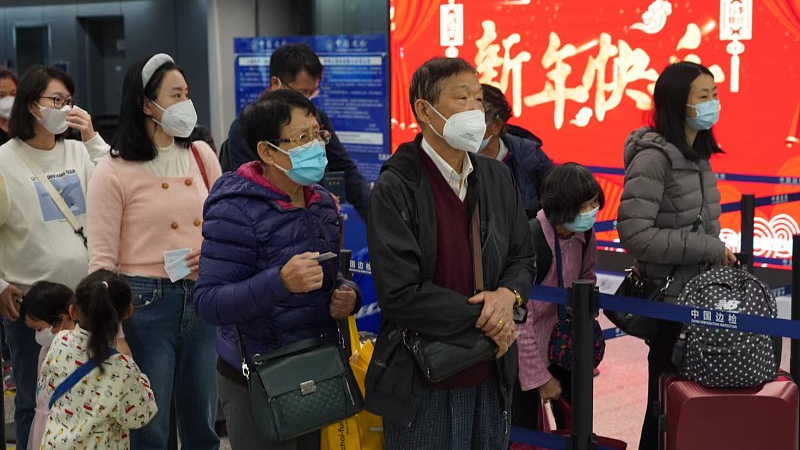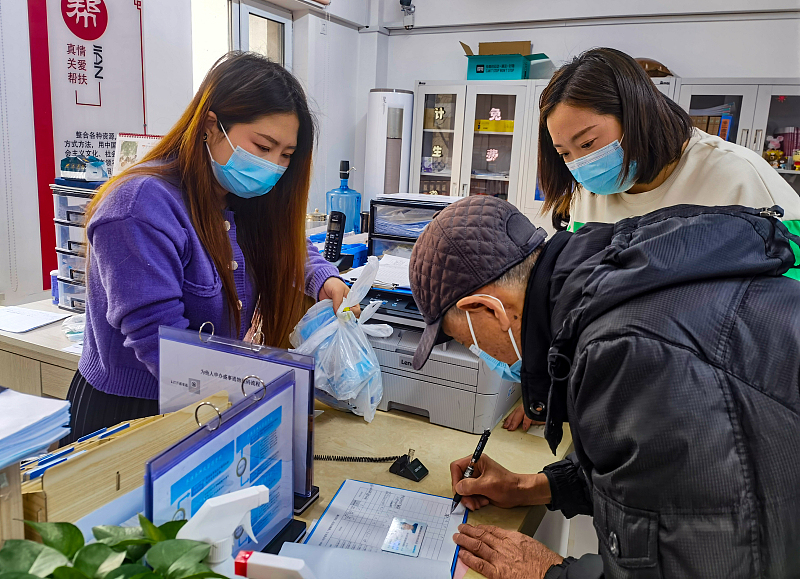
Hong Kong passengers arrive at the Zhuhai Highway Port of the Hong Kong-Zhuhai-Macao Bridge and line up for border inspection in Zhuhai, south China's Guangdong Province, January 8, 2023. /CFP
Hong Kong passengers arrive at the Zhuhai Highway Port of the Hong Kong-Zhuhai-Macao Bridge and line up for border inspection in Zhuhai, south China's Guangdong Province, January 8, 2023. /CFP
Editor's note: Yin Xiaoxv is a professor at the Department of Social Medicine and Health Management of Tongji Medical College under Huazhong University of Science and Technology. The article reflects the author's opinions and not necessarily those of CGTN.
From January 8, 2023, China starts managing COVID-19 with measures designed for combating Class B infectious diseases, instead of Class A infectious diseases. Such a downgrade in management measures is another major adjustment in China's COVID-19 response policy, ushering in a new phase of the COVID-19 response in China.
For a long time, the Chinese health authorities have divided infectious diseases into three categories according to their transmission speed and degree of harm.
Class A infectious diseases, such as the plague and cholera, spread quickly and are the most harmful, and are managed through mandatory measures. The Class B infectious diseases, which include tuberculosis, malaria and AIDS, just require strict responses. Class C infectious diseases, on the other hand, are those under active monitoring and management.
Classified management, dynamic adjustment and science-based precision control have been the basic strategy of China's response to infectious diseases. The latest adjustment of China's epidemic prevention and control measures is also based on this strategy, which is a proactive and scientific approach to COVID-19 prevention and control.
In terms of pathogenic features, the pathogenicity of Omicron is lower than that of other variants, and its impact on the health of the population is within a controllable range. This is the premise for the adjustment of China's response measures.
The Omicron variant mainly invades the upper respiratory tract, and the infected people mostly have symptoms such as fever, dry or sore throat and cough, while the proportion of patients with serious illnesses such as pneumonia in the lower respiratory tract is low. Less than 10 percent of the patients develop pneumonia, and the share of patient suffering critical conditions is low, according to China's National Health Commission.
The low pathogenicity and manageable impact of the disease have guided the policy shift on China's COVID-19 response, which is in line with the interests of the vast majority of the Chinese and a testament to China's commitment to putting people's life first.
And in terms of infectious features, Omicron spreads very fast, with R0 (basic reproduction number) even exceeding 20. It's difficult to prevent and control Omicron with lockdown measures. This is the background for the adjustment of the COVID-19 response policy in China.

Community workers distribute free health supplies to an elderly in Shenyang, northeast China's Liaoning Province, January 11, 2023. /CFP
Community workers distribute free health supplies to an elderly in Shenyang, northeast China's Liaoning Province, January 11, 2023. /CFP
The symptoms of Omicron-infected patients are similar to those of influenza patients, and it's difficult to distinguish between the two infections. This has led to a significant increase in cases due to the widespread movement of infected people at the community level.
Over the past year, Omicron has spread to all parts of the world. Global prevention and control practices have proven that Omicron cannot be eradicated. Therefore, China chose to optimize its response to COVID-19, balancing epidemic control with socio-economic development. The adjustment is made based on the current reality of COVID-19 response and in line with the global response strategy against Omicron.
Moreover, in terms of the timing of the adjustment, it is done during the window of opportunity for a shift in response strategy. Doing it before or after this time window is undesirable. As Liang Wannian, head of China's COVID-19 response expert panel under the National Health Commission, said that if China's response policies were adjusted earlier, China would have been underprepared over the pathogenicity of the disease, the experience in transmission control and level of immunity of the population. A hasty adjustment could have led to an incalculable impact.
The vaccination rate of the Chinese is on the rise, especially among high-risk groups such as the elderly. For example, the full-dose vaccination rate of people aged 60-79 in Henan Province is 98.49 percent and that of the elderly in Hubei Province reaches 90.7 percent. The level of immunity among the entire population has risen.
Likewise, if the adjustment is delayed and the best time window is missed, as the virus mutates constantly and may get even more dangerous, the impact of a belated policy adjustment could make matters worse. Given that the Omicron variant is less pathogenic than previous variants, it is best to adjust the response strategy and measures now.
China has also made preparations for optimizing the COVID-19 response. China has made an array of active adjustments to optimizing the COVID-19 response, such as 20 measures on November 11 last year, 10 new measures on December 7, etc.
The optimization is gradual and based on the latest developments. The policy changes are necessary, timely and science-based by following closely on the features of the virus and its transmissibility. They are made with good coordination and planning by analyzing the changes in the epidemic situation.
The downgrade in the management of COVID-19 as a Class B infectious disease is a proactive move to optimize response measures based on a comprehensive assessment of the pathogenic and infectious features of the virus and with careful consideration over the timing. It demonstrates the scientific, precise and effective nature of China's epidemic prevention and control work.
(If you want to contribute and have specific expertise, please contact us at opinions@cgtn.com. Follow @thouse_opinions on Twitter to discover the latest commentaries in the CGTN Opinion Section.)